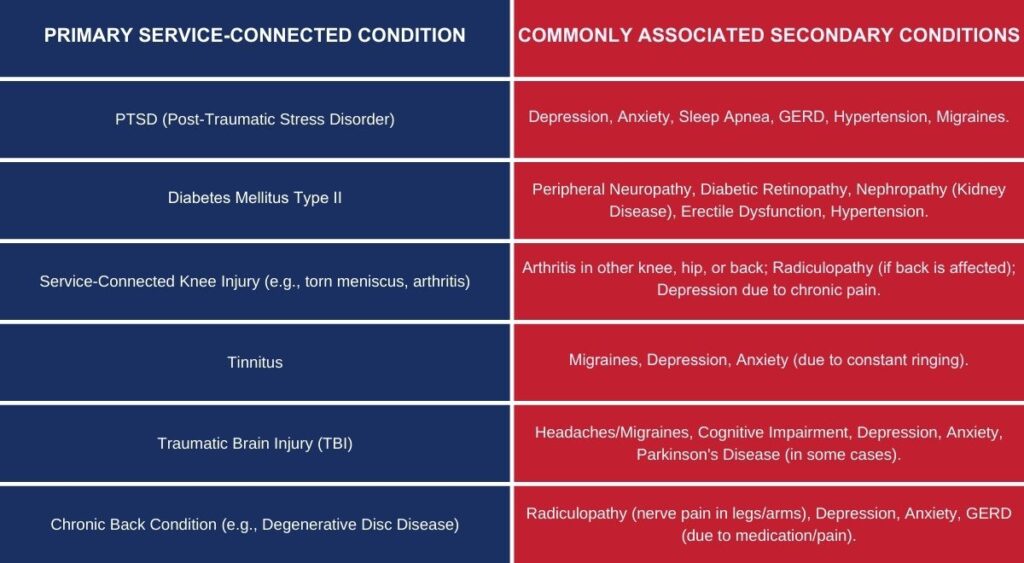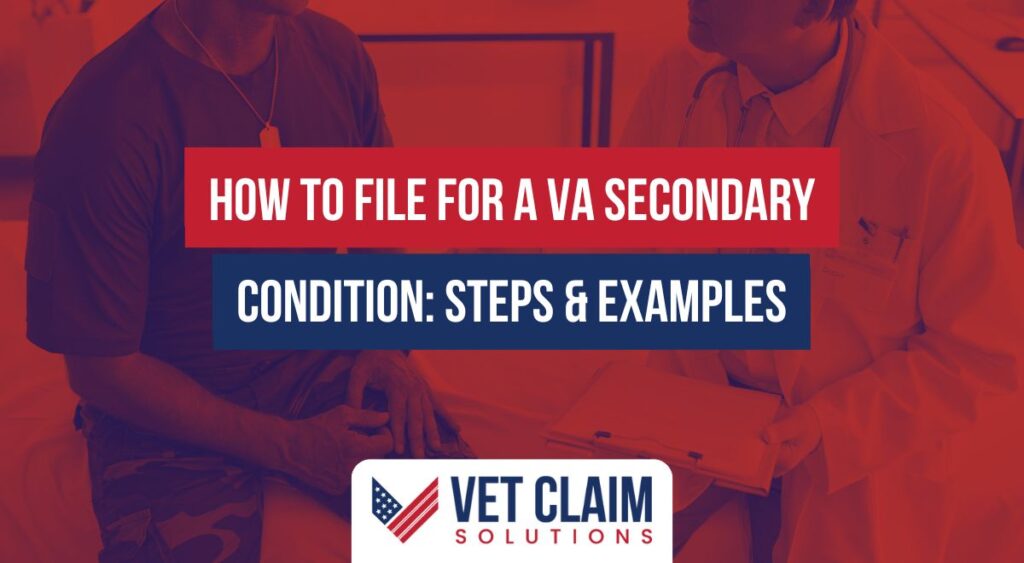Are you a veteran dealing with new health problems that seem connected to your existing service-connected disabilities? You might be asking how to get additional VA disability benefits for these new conditions. This guide explains How to File for a VA Secondary Condition, Provides examples and steps for linking conditions to service-connected ones.
Many veterans face this situation, unsure where to begin their VA claim or if their new ailment qualifies as a secondary service connection. It can feel overwhelming, especially when you are already managing your health and an existing VA disability. Understanding this process for a secondary VA claim can significantly impact your disability compensation and overall well-being.

What Exactly is a VA Secondary Condition?
A VA secondary condition is a health issue not directly caused by your military service but stemming from an existing service-connected disability. It’s like a domino effect; one health problem, often a primary disability, can lead to another, which is then considered a secondary disability. This is a common scenario for many seeking increased disability compensation.
The Department of Veterans Affairs acknowledges that your service-connected disability can trigger new health problems or aggravate conditions that were not previously service connected. If you can successfully demonstrate this link, also known as a medical nexus, you could receive additional disability benefits. This means the disability that’s linked can increase your overall disability rating.
The focus here is not on an event during your service. Instead, it’s about the consequences of an already established service-connected condition. Proving this specific connection is crucial for your VA disability claim.
Common Examples of Secondary Conditions
It helps to see some real-world examples. This can make the idea of a secondary condition clearer. Many veterans experience similar patterns when developing a secondary service-connected issue.
Diabetes Leading to Other Issues
Suppose you have a service-connected Type II Diabetes. Over time, this primary disability can lead to other health problems. Peripheral neuropathy, causing nerve damage and pain in the feet and hands, is a frequently claimed secondary condition.
Kidney disease (nephropathy) is another severe condition often linked to diabetes, potentially requiring significant medical care. Eye problems such as diabetic retinopathy can also develop, impacting vision. These related health issues are prime examples of conditions that can be claimed as a secondary service connection.
PTSD and Its Ripple Effects
Post-Traumatic Stress Disorder (PTSD) is a serious mental health challenge for many veterans. The intense stress from PTSD can contribute to other physical and mental health conditions. Depression is very commonly diagnosed alongside PTSD and can be claimed as a secondary service-connected disability.
Sleep apnea is another condition frequently linked to PTSD, sometimes due to weight gain which can be a side effect of PTSD medications. This weight gain might also contribute to high blood pressure (hypertension) or other metabolic issues. Proving this pathway of connection is vital for these types of secondary VA claims.
Orthopedic Injuries Causing New Problems

Consider having a service-connected knee injury, a common primary disability for veterans. To manage pain or instability from this knee condition, you might alter your gait. This change in how you walk can place additional stress on your other knee, hips, or back.
Over time, this compensatory strain can lead to degenerative conditions like arthritis in the contralateral knee or chronic back pain. These new orthopedic issues could be claimed as secondary to your original service-connected knee injury. Filing a VA secondary claim for these can lead to an increased disability rating and access to more VA health care.
Hypertension Leading to Heart Disease
If you have service-connected hypertension (high blood pressure), it continually strains your heart and blood vessels. Over many years, this ongoing strain can lead to severe heart conditions. Coronary artery disease, heart failure, or even a stroke could potentially be linked as a secondary condition.
Demonstrating how the service connected hypertension directly contributed to the development of such heart disease is fundamental for this disability claim. Comprehensive medical records and strong medical opinions are especially critical when the disability that’s linked involves complex organ systems. Some veterans might even find that if their service-connected disability prevents them from working, they could explore options like Total Disability Individual Unemployability (TDIU).
Chronic Pain Leading to Mental Health Issues
Many veterans live with chronic pain resulting from service-connected injuries, such as a back condition or shrapnel wounds. Constant pain can severely impact a veteran’s quality of life and emotional well-being. This can frequently lead to the development of mental health conditions.
For instance, depression or anxiety can arise as a direct result of coping with persistent, debilitating pain. If your primary service-connected disability is chronic pain, and you subsequently develop a mental health condition like depression, that mental health issue may be considered a secondary disability. Gathering statements from mental health professionals is important for this type of secondary service connection.
Common Primary to Secondary Condition Pathways
To further illustrate, here’s a table showing some common primary service-connected disabilities and the secondary conditions that frequently arise from them. This is not an exhaustive list, but it provides a good overview. Understanding these connections can help you identify potential secondary claims.

Remember, each VA claim is different, and establishing a medical nexus is essential for any secondary service connection. This often requires specific medical evidence and nexus letters linking your conditions.
Why Pursue a Secondary Service Connection?
You might wonder if filing another VA claim is worth the effort. The answer is a resounding yes for many veterans. Successfully claiming secondary conditions can lead to an increased disability rating, which often translates to higher monthly disability compensation.
Beyond the financial aspect, it is about receiving full recognition for the extent of your service-connected disabilities. This acknowledgment can also grant access to broader VA health care services for these related conditions. Furthermore, if your combined disabilities, including secondary ones, prevent you from maintaining substantially gainful employment, you might qualify for Total Disability based on Individual Unemployability (TDIU), leading to increased disability compensation at the 100% rate.
Understanding how the VA combines disability ratings can be complicated, and tools sometimes referred to as a disability calculator can offer an estimate, but the official VA decision will provide the final disability rated percentage. Pursuing every legitimate secondary VA claim helps build a complete picture of your health; if your overall condition is worse, you’ll want your situation fully recognized. Failing to pursue a legitimate secondary claim means you might not receive benefits for a condition that significantly impacts your quality of life.
Understanding the Medical Link, or “Nexus”
The cornerstone of any successful secondary condition VA claim is proving the medical nexus. This “nexus” signifies the direct link demonstrating that your new health issue was either caused or aggravated by your existing service-connected disability. This is a critical component of your disability claim.
A well-drafted nexus letter from a qualified medical professional is invaluable. This document should articulate the medical rationale connecting your primary service-connected condition to the secondary condition. Without this clear medical nexus, your secondary service connection claim will likely be denied by the Veterans Affairs.
Consider the nexus the essential bridge between your two conditions. Sufficient medical evidence, including diagnostic reports from a recent medical test, is required to construct this bridge convincingly for the VA.
How to File for a VA Secondary Condition: Examples and Steps for Linking Conditions to Service-Connected Ones
Let’s outline the practical steps for filing your va secondary claim. Knowing what to do can make the process of seeking these disability benefits more manageable. You can approach this by focusing on one step at a time.
Step 1: Confirm Your Primary Condition is Service-Connected
This may appear straightforward, but it is the absolute foundation of your secondary claim. You cannot file for a secondary condition if the primary disability it stems from is not already recognized by the VA as service connected. If it is not, your initial step must be to establish service connection for that primary disability.
Review your VA decision letters or check your account on the official VA.gov website, a key federal government website for veteran services. This will confirm your current service-connected disabilities and their ratings. This information is your starting point for any secondary VA claim.
Step 2: Gather Your Medical Evidence
Medical evidence is crucial for any va disability claim, especially for a secondary service connection. You need comprehensive medical records that demonstrate the link between your conditions. This includes notes from doctor’s visits, results from any relevant medical test, and reports from specialists.
If your medical professional states, for example, “The patient’s current GERD is likely exacerbated by the NSAID medications prescribed for their service-connected knee condition,” this is highly valuable. Strive to get such connecting statements in writing from your health care provider. You must provide proof that the secondary condition is at least as likely as not (a 50% or greater probability) caused or aggravated by the primary service-connected disability.

A dedicated nexus letter from a healthcare provider is particularly persuasive. This document should detail how the primary disability directly caused or worsened the secondary condition, referencing medical literature if applicable to strengthen the medical nexus. This kind of detailed medical evidence forms the backbone of a strong disability claim.
Step 3: Understand Aggravation – When a Pre-Existing Condition Worsens
In some cases, you might have a health condition that existed before your military service or one that developed after service but was not initially service-connected. If this non-service-connected condition is demonstrably worsened by an existing service-connected disability, this is known as aggravation. You can file a va claim for aggravation of a non-service-connected disability.
For instance, if you had mild, non-service-connected tinnitus, but a subsequently service-connected TBI significantly increases the severity and impact of the tinnitus, you could claim aggravation. You would need medical evidence showing how the service-connected TBI worsened the tinnitus beyond its natural progression. The key is to show that the service-connected disability prevents the condition from remaining at its baseline.
Proving aggravation requires careful documentation. You will need medical evidence establishing the baseline severity of your condition before it was aggravated by your service-connected disability. Then, you must show how the primary disability caused the worsening.
Step 4: Filing Your VA Claim
With your evidence compiled, you are ready to file your disability claim. The primary VA form for this purpose is VA Form 21-526EZ, “Application for Disability Compensation and Related Compensation Benefits.” You can submit this va form online via the VA.gov official website, by mail.
When completing the VA Form 21-526EZ for your secondary claim, be explicit. Clearly state that you are claiming a specific condition (e.g., radiculopathy) as secondary to an already service-connected condition (e.g., a lumbar spine disability). Making this connection unmistakably clear is important for the VA rater reviewing your va disability claim.
Thoroughly review all information on your application for accuracy and completeness. Submitting a well-prepared va claim from the outset can help avoid delays in processing your request for disability benefits. If you have previously been denied for this condition, you might file a supplemental claim with new and relevant evidence.
Step 5: Craft a Strong Personal Statement (Lay Evidence)
Your personal statement, formally submitted on VA Form 21-10210 (“Lay/Witness Statement”), provides an opportunity to describe your situation in your own words. Explain how your primary service-connected condition has caused or aggravated your secondary condition. Detail the symptoms of the secondary disability and their impact on your daily activities and quality of life.
While not medical evidence in a technical sense, this lay evidence is valuable. It helps the VA rater understand the progression and impact of your disability that’s linked to service. You can describe the timeline of when the secondary symptoms began and how they evolved after your primary condition was established, showing how the primary service-connected disability prevents you from living as you once did.
Statements from friends, family members, or former colleagues who have witnessed how these conditions affect you can also serve as powerful lay evidence. These buddy statements can corroborate your account and strengthen your overall disability claim. For women veterans, statements addressing specific impacts on their roles and responsibilities can be particularly insightful.
Step 6: Prepare for the Compensation & Pension (C&P) Exam
The Department of Veterans Affairs will likely schedule you for a Compensation & Pension (C&P) exam for your claimed secondary condition. A VA doctor or a VA-contracted medical professional conducts this examination. Its purpose is to assess your secondary disability and, crucially, to obtain a medical opinion on its nexus to your primary service-connected disability.

Be candid and comprehensive during your C&P exam. Clearly explain all your symptoms, their severity, frequency, and how they affect your daily life and ability to work. If the examiner inquires about the link to your primary condition, articulate your understanding of this connection and how the primary service-connected disability contributes to the secondary one.
Consider bringing copies of your essential medical evidence, including any private nexus letters and your personal lay statement, to the C&P exam. While the examiner should have access to your VA claim file, providing your own copies can be helpful. This exam is a critical part of the VA’s process for evaluating your disability claim.
Common Hurdles and Helpful Pointers
Filing any VA claim can have its bumps. Being aware of common issues can help you prepare better. Don’t get discouraged if things seem tough, as persistence can pay off when pursuing a secondary service-connected disability.
The Primary Hurdle: Lack of a Clear Medical Nexus
The most common reason for denial of secondary va claims is the absence of a definitive medical nexus. Without a strong medical opinion linking your secondary condition to your primary service-connected one, the VA cannot grant service connection. Therefore, concentrating on obtaining a compelling nexus letter or medical statement is paramount.
If your treating medical professional seems reluctant or unsure how to draft such a letter, explain precisely what the VA requires. Providing them with a sample nexus letter format can clarify what information is needed for your va disability claim. Many healthcare providers are willing to assist but may be unfamiliar with the specific documentation Veterans Affairs requires.
Insufficient Supporting Evidence
Merely asserting that one condition caused another will not suffice for a successful disability claim. You must furnish robust supporting evidence, including comprehensive medical records, well-reasoned doctor’s opinions, and potentially medical journal articles that corroborate the connection. The greater the volume and quality of your supporting evidence, the more persuasive your secondary service-connected claim becomes.
Maintain complete copies of all documents you submit to the VA for your disability compensation claim. Keep your records well-organized.
Lack of Clarity in Your VA Claim Submission
Make certain your VA form and accompanying documentation explicitly state you are seeking service connection for condition ‘B’ as secondary to the already service-connected condition ‘A’. Do not leave it to the VA rater to infer the nature of your disability claim. Precision and clarity are very helpful throughout the VA claims process.
Employ correct terminology where possible. Using phrases like “secondary service connection” or “aggravation of a pre-existing condition due to service-connected disability” helps frame your claim accurately. If your disability that’s linked is due to aggravation, articulate this clearly and provide the necessary comparative evidence.
The Decisive Impact of a Strong Nexus Letter
We have highlighted nexus letters previously, but their critical importance in a secondary va claim warrants further discussion. A thoroughly written nexus letter from a medical professional can often be the pivotal piece of evidence in your disability claim. It supplies the clear medical rationale the VA requires to establish a secondary service connection.
What constitutes a high-quality nexus letter? It must clearly identify the veteran and their established primary service-connected condition. It then needs to precisely state the secondary condition being claimed and the basis for the link, for instance, a disability that’s linked through causation or aggravation.
The central part of the nexus letter is the medical opinion. The doctor must explain, leveraging their medical expertise and a review of your medical records, how the primary service-connected disability caused or worsened the secondary one. Crucially, the letter should use language such as “it is at least as likely as not” (a 50% or greater probability) or “it is more likely than not” that the conditions are linked. Confirming that the medical professional has reviewed your relevant medical history adds weight to their opinion.
While any licensed physician can author a nexus letter, a letter from a specialist in the field relevant to your secondary condition typically carries more evidentiary weight. For instance, if you are claiming a heart condition as secondary to service-connected high blood pressure, a nexus letter from a cardiologist would be exceptionally persuasive. Accessing appropriate health care and discussing these needs with your provider is a good first step.

Using Precise Language in Your VA Claim
The terminology you employ in your va claim and supporting statements matters significantly. When describing the connection between your conditions, try to use language that reflects the VA’s evidentiary standards. Phrases indicating a clear and probable link are most effective for your disability claim.
For example, you could state: “My gastroesophageal reflux disease (GERD) developed as a direct consequence of the NSAID medications prescribed for my service-connected knee condition.” Alternatively: “The chronic pain stemming from my service-connected lumbar spine injury has substantially aggravated my pre-existing, non-service-connected anxiety.” Direct and precise language helps the VA understand the foundation of your secondary service connection claim. This disability we’ve discussed needs clear articulation.
What If Your Secondary VA Claim is Denied?
Receiving a denial for your secondary condition claim can be disheartening. However, a denial is not always the final outcome. The Department of Veterans Affairs provides several avenues for appealing an unfavorable decision regarding your va disability.
The VA will issue a decision letter detailing the reasons for the denial. Review this document thoroughly, as it will specify what was lacking in your original disability claim, frequently pointing to an insufficient medical nexus or inadequate supporting medical evidence. It’s official VA communication, so take it seriously.
You have options: you can file a Supplemental Claim by submitting new and relevant evidence that was not previously considered. Alternatively, you can request a Higher-Level Review by a more experienced adjudicator, or you can appeal directly to the Board of Veterans’ Appeals.
Successfully Claiming Secondary Conditions
Filing for VA secondary conditions is achievable when you understand the necessary steps and evidentiary requirements. It requires careful preparation and compelling evidence, but securing these disability benefits can profoundly improve your quality of life and financial stability. The fundamental aspect is demonstrating a clear medical link between your new health issue and your existing service-connected disability.
Knowing How to File for a VA Secondary Condition, including understanding examples and the steps for linking conditions to service-connected ones, empowers you to pursue the disability compensation you have rightfully earned. This process allows you to obtain a disability rating that reflects the true extent of your service-related health issues.
Do not hesitate to use these resources or seek professional guidance if you encounter challenges with your VA claim. The goal is to make certain your disability that’s linked to service is properly recognized and compensated by the Veterans Affairs system. Persisting with your secondary claim can lead to increased disability support and access to needed health care.


